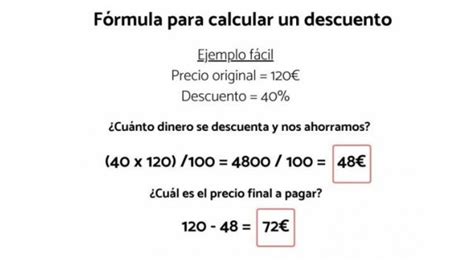Como Calcular El Descuento De Un Precio
Treneri
Apr 04, 2025 · 4 min read

Table of Contents
How to Calculate a Discount: A Comprehensive Guide
Calculating discounts might seem straightforward, but understanding the different methods and nuances can be beneficial for both personal finance and business dealings. This comprehensive guide will walk you through various scenarios, offering clear explanations and practical examples to help you master discount calculations. Whether you're a savvy shopper trying to maximize savings or a business owner managing sales and promotions, this guide will equip you with the knowledge you need.
Understanding the Basics of Discounts
Before diving into calculations, let's define some key terms:
- Original Price: The initial price of a product or service before any discount is applied.
- Discount Rate: The percentage reduction offered on the original price. This is often expressed as a percentage (e.g., 20%, 50%) or a fraction (e.g., 1/4, 1/2).
- Discount Amount: The actual monetary value of the reduction. This is calculated by multiplying the original price by the discount rate.
- Final Price (Sale Price): The price you pay after the discount has been applied. This is calculated by subtracting the discount amount from the original price.
Method 1: Calculating the Discount Amount and then the Final Price
This is the most common and straightforward method. It involves two steps:
Step 1: Calculate the Discount Amount
The formula for calculating the discount amount is:
Discount Amount = Original Price × Discount Rate
Example: A shirt costs $50, and there's a 20% discount.
Discount Amount = $50 × 0.20 = $10
Step 2: Calculate the Final Price
The formula for calculating the final price is:
Final Price = Original Price - Discount Amount
Example (Continuing from above):
Final Price = $50 - $10 = $40
Therefore, the final price of the shirt after a 20% discount is $40.
Method 2: Calculating the Final Price Directly
This method is more efficient as it calculates the final price in a single step. It uses the concept that if you have a 20% discount, you're paying 80% (100% - 20%) of the original price.
Step 1: Calculate the Percentage Remaining
Subtract the discount rate from 100%.
Percentage Remaining = 100% - Discount Rate
Example: With a 30% discount, the percentage remaining is 100% - 30% = 70%.
Step 2: Calculate the Final Price
Multiply the original price by the percentage remaining (expressed as a decimal).
Final Price = Original Price × (1 - Discount Rate)
Example (Continuing from above): A $75 item has a 30% discount.
Final Price = $75 × (1 - 0.30) = $75 × 0.70 = $52.50
The final price of the item is $52.50.
Handling Multiple Discounts
Sometimes, you might encounter scenarios with multiple discounts applied successively. It's crucial to understand that applying discounts sequentially is different from simply adding them together. Each discount is applied to the price after the previous discount has been applied.
Example: A $100 item has a 10% discount, followed by an additional 5% discount.
Step 1: First Discount
Discount Amount = $100 × 0.10 = $10
Price after first discount = $100 - $10 = $90
Step 2: Second Discount
Discount Amount = $90 × 0.05 = $4.50
Price after second discount = $90 - $4.50 = $85.50
The final price after both discounts is $85.50. Note: This is not the same as a 15% discount ($100 - ($100 x 0.15) = $85).
Calculating the Original Price from the Discounted Price
This situation is common when you know the final price and the discount rate, but need to find the original price.
Formula:
Original Price = Final Price / (1 - Discount Rate)
Example: An item costs $60 after a 25% discount. What was the original price?
Original Price = $60 / (1 - 0.25) = $60 / 0.75 = $80
Discounts with Added Tax
When dealing with discounts and sales tax, the order of operations matters. Generally, the discount is applied first, then the tax is calculated on the discounted price.
Example: A $200 item has a 15% discount, and a 6% sales tax applies.
Step 1: Discount
Discount Amount = $200 × 0.15 = $30
Price after discount = $200 - $30 = $170
Step 2: Sales Tax
Sales Tax Amount = $170 × 0.06 = $10.20
Final Price = $170 + $10.20 = $180.20
Real-World Applications and Tips
- Shopping: Always check for multiple coupons or discounts to maximize savings. Compare prices and discounts from different stores.
- Business: Understanding discount calculations is crucial for pricing strategies, sales promotions, and profit margin analysis.
- Finance: Discounts and interest rates are closely related concepts. Understanding discount calculations improves your financial literacy.
- Negotiation: Knowing how to calculate discounts empowers you to negotiate better deals.
Conclusion
Mastering discount calculations is a valuable skill with wide-ranging applications. Whether it's for personal shopping, business decisions, or general financial understanding, the methods and examples provided in this guide empower you to confidently handle various discount scenarios. By understanding the different approaches and their nuances, you can make informed decisions, save money, and improve your financial acumen. Remember to always double-check your calculations to ensure accuracy. Practice these techniques with different examples to solidify your understanding. With consistent practice, discount calculations will become second nature.
Latest Posts
Latest Posts
-
Center And Radius Of Sphere Calculator
Apr 04, 2025
-
50 To The Power Of 2
Apr 04, 2025
-
How Many Gallons In 14 Quarts
Apr 04, 2025
-
How Hard Can A Human Punch
Apr 04, 2025
-
Mean And Standard Deviation Of Sampling Distribution Calculator
Apr 04, 2025
Related Post
Thank you for visiting our website which covers about Como Calcular El Descuento De Un Precio . We hope the information provided has been useful to you. Feel free to contact us if you have any questions or need further assistance. See you next time and don't miss to bookmark.
